Community aspiration and town hall
February 8, 2015 by John_Smith
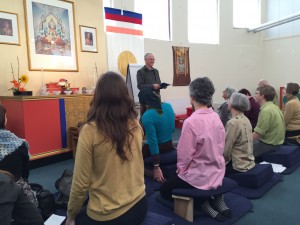
David Parker introduced the contemplations.
From the beginning, when we were planning our community aspiration event, we knew that all 120 members couldn’t fit in the room even if everybody could be there at the same time. So my job was to share some of the discussion and provoke reflection on some important questions that are up for all of us, as individuals and as a community. Thinking about what we want to do individually and collectively seems like a natural thing to do together although it isn’t something we can wrap up in one afternoon. You might bring these questions up with friends in Shambhala: “what’s up with you? with you and Shambhala? with you and the world?” Here’s my report on the 2015 “Members only event” to get the ball rolling.
There were 32 people who all squeezed into shrine room for a 3-part program that was planned by David Engelbrecht, Corey Adkins, Jay Stewart, David Parker, and me. The first part was an opportunity for us all to reflect on our aspirations for the coming year. The second was a Town Hall, led by our Director Lisa Stanley and Council Secretary Corey Adkins who reported on the aspirations and goals that the Center’s Governing Council articulated in its December 2014 retreat. The third part was, of course, a yummy potluck followed by shared music, poems and art.
The membership aspiration event involved our asking ourselves the very questions that Sakyong Mipham asked himself during his 2010 year in retreat. The questions and the event seemed so appropriate we thought it might be scheduled every year. We need to give ourselves regular opportunities to contemplate and refresh our intentions regarding practice, study, community, and action in the world — as individuals and as members or leaders in Shambhala and the world. In his introduction David Parker suggested that we should avoid judgmental or comparative mind in the contemplations he led. He suggested that we could experiment with making decisions from a place of contentment not anxiety, with gentleness and curiosity.
- What do we want to commit to, to engage with in personal practice this year? (… a silent contemplation where we could write down our thoughts)
- What want to offer to the Shambhala community in coming year? (… a silent contemplation followed by discussion in small groups, followed by a group-wide discussion summarized below)
- What do I want to offer the greater world this year? (… a silent contemplation followed by individual discussions and posting on the wall)
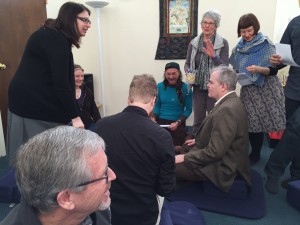
We organized into small groups to discuss our intentions for the next year.
Here are some of the intentions that people shared with respect to their involvement in the Shambhala Center:
- Spending more time together at the Shambhala center – in community
- Not “just be a member” but “engage more deeply in those activities I’ve committed to.” More heartfelt engagement, continue learning how to be kind.
- Find a harmonious balance between practice and daily life in a way that would be sustainable: between “personal life” and “Shambhala life” (for some that meant cutting back while for others it meant increasing engagement in Shambhala activities)
- Bring good food to potlucks
- Offer our specific skills: cooking, guarding, leading, etc.
- Maintain or increase monthly dues
- Increase integration of people from all sides (geographical and social) of Portland
- Reach out to veterans and other groups, outing ourselves as Buddhists
- Increase focus on social action, especially diversity issues
- Work toward finding a new space for our Shambhala Center.
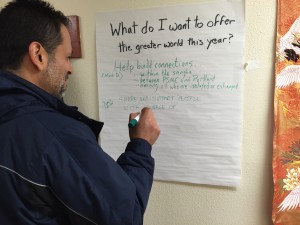
Juan Carlos, a new member of Shambhala, who was talking about bringing the courage of basic goodness to human rights organizations. He is a consultant for Amnesty International and other organizations.
Town Hall
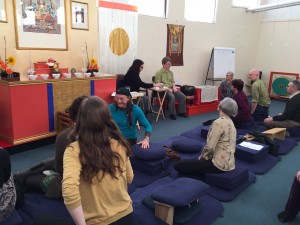
Lisa Stanley and Corey Adkins led the Town Hall meeting.
Lisa Stanley opened the town hall by recalling a conversation with someone who was stepping out of a role they had held. They were wondering, “how to be here [at the Shambhala Center] if I’m not doing a specific role?” Lisa led a reflection on what it means to be a member of the community: recall Pema’s teachings on “come as you are.” It starts with that. Whatever it is that we are experiencing, whether challenges, richness, our gifts (large or small), the delight we can take in one another or in our lives. Also our foibles, our faults, our neuroses, the irritations with ourselves and with others, our conflicts — all of that is part of the notion of coming as you are. We should know that that’s why this community exists: to hold dear our humanness. Not the idea of moving toward perfection. We are not trying to be perfect or have a perfect society. It’s more about having a place where we can hold our heart, which is our strength. Like meditation: “strong back and soft front” applies to meditation and to our lives. This is a place where the lineage, our practice and our lives come together. We could be supported and nourished here but never give up: on ourselves or on others.
Corey Adkins followed Lisa by describing the plan for the Town Hall: to share goals that Council came up with during its retreat in December. Corey presented the first three, followed by a discussion and then Lisa presented the last two, followed by a discussion. The idea was to start a conversation within the community even though we clearly couldn’t complete it. The three priorities that Corey reported on were diversity, transparency, and creating a culture of kindness. In each case, he talked about the ground (G: where we are or have been, what work has already occurred), the path (P: what’s happening now or needs to happen now), and the fruition (F: where we want to end up). (The following notes are very rough.)
Diversity:
G: Bringing out voices not currently in the community. Have affinity groups, YM, NLA, Queer Dharma. Michaela has done a lot of outreach to SMIRF, Native American youth & family center. Americorp training. six-week class on diversity.
P: Invite more communication in the community. Who’s interested. What is missing, what our our blind spots? Accessibility of this building.
F: Hoping to bring to light what we’re not seeing, open things up.
Transparency :
G: Council visibility, town hall, making the community more visible to itself. Monthly blog post with council minutes.
P: New ways of getting feedback for leadership (town hall & other ways). Talking about how we engage with each other.
F: We would like feedback. Do our blog posts work? Would like increased conversation between the Council and the community, more collaboration. Visibility of council membership, able to put topics on the Council’s agenda. Transparency includes seeing ourselves in the larger mandala context.
Cultivating a culture of kindness:
G: Council work on team building and communication efforts. Hope to share it with community. Corey and Jay headed the effort.
P: (Handed out two pages from Thick Nhat Han book, Joyfully Together.) There is a mandala-wide grievance process for serious issues; making that more accessible and visible to community. People who can serve as mediators: Jay as Pathfinder person who’s trained in transformative mediation. Michaela as a trained mediator. Membership appreciation event and programs on communication. Figuring out how to work with burnout. Acharya Ferguson’s upcoming program on bodhisattva path.
F: View is that conflict is part of our path. It’s not a breakdown or a failure. It’s an opportunity to practice.
Discussion and suggestions:
- How about an electronic suggestion box?
- Our organization is too opaque: how do we select leaders? Who gets on the council and for how long? Who chooses Council members? What other positions are there? It’s a mysterious process.
- Moved by the words: “Sangha burnout happens”. Good to know ourselves: how we practice this way. Important as part of transparency: individual leaders or the whole sangha experiencing burnout. When it’s happening and how we can uplift ourselves together. That would bring true friendship if we had the tough conversations.
- Efforts to hang out with people who are on the periphery (rather than wait for people to come in and speak to council). People who are within the sangha who are on the periphery of the community.
- Are council meetings open to the Sangha?
- Approaching seniors who feel lost and alone.
- Access Council. Restrictive process for observing. Publish when council meetings are happening and publish the agenda. It’s a black hole: nobody knows what’s going on.
Further on the culture of kindness:
- We have tremendous resources regarding conflict and communication. Would like to have meetings like these to practice conflict resolution skills with each other.
- “We have to learn how to not get along better.” Would a session about that be fun or inviting?
- Efforts to take care of each other are paying off. The vibe in the center has warmed up. Greeters on Tuesday nights or Sunday practice matter a lot.
- Our goal is “kind and not asleep.” Awake means protective of our environment, of the dharma, of each other. We need to have more awareness of what has led to some thefts.
- To help reduce chronic inventory shrinkage in the bookstore, we could offer to help people with the process of buying a book when people are browsing there. We could say, “Would you like to buy a book?”, or “Can I help you with buy that book?”
Lisa presented the next two topics: wealth & money and getting a new space.
Wealth and money. Sakyong teaching more about this, regarding money as path and how we work with that. Includes teaching and practice as well as structural changes in Shambhala. Shambhala view of money is not based on fear or competition or scarcity that prevails in the surrounding culture. Trungpa Rinpoche taught a lot about money, that the ground is appreciation of what we possess, contentment. Generosity arising from genuine connection. From confidence, not fear. Using good financial practices means having a lot of discipline. There is a lot happening an international level. Unified Giving Model is about interdependence. Center of the Mandala, all of the centers and individuals are all interconnected. In the past there’s been a regional or center-focused attitude (“our money”). Meanwhile some are dining on steaks, while others have beans and rice diets. There is a new Kalapa envoy on enrichment. Care for and propagate notions on enrichment.
We are in good financial health. We met our goals and have exceeded them a bit each year, by about two or three thousand dollars. That then feeds back into a variety of things, programs and opportunities such as: prison dharma, environmental uplifts, scholarships for members to attend major programs, sponsoring teachers to attend training program, and leaders to attend governance programs. We tried to establish a wealth committee, but it fell through. We haven’t given up. So the fruition in this area is to manifest a sane and visionary approach to wealth at community and individual levels.
New space: Thinking about a new space has come from recognizing that we do not have enough space here for all the classes, book groups, and programs that we want. Also, we have found that we have some security problems. Kitchen space isn’t adequate so that we can’t easily cook or eat together. And we are not wheel-chair accessible. We do have to work with what we’ve got. We have an environmental group consisting of Bettina Hetz as our Culture and Decorum representative, Abbey and I. We’ve cleared out the annex, changed the office, and moved the mahakhala shrine. We have a stroke practice table. We have been trying to uplift the space.
This would be the third time that our community has tried to move forward on space. Council approved a committee: chaired by Lisa and Bettina. Lisa met with Connie Brock, the chief financial officer of Shambhala. The process she outlined is that Centers prepare proposals and SI approves them. Connie’s suggestions include visioning with the community, taking a fresh start, being mindful of the tone of conversation, think about why we want to move and we want to manifest. It’s important to allow space for inspiration as well as concerns. We need to include it all: work with diverse points of view to seek broad agreement. First we would do a feasibility study and out of that a visioning process. Then after that we could have an active search. I hope to start after Shambhala Day. I look forward to having a community visioning process.
In all of this, how we think about membership in Shambhala is very important. Traditionally we think of the first three, but the fourth is emerging as very important:
- Practice — for benefit of self and others,
- Volunteer time in small or large ways,
- Contribute financially,
- Practice of community.
The practice of community has always been part of Shambhala, but the Sakyong is asking us to enrich that aspect and to be more aware of it. We are taking an appreciative inquiry perspective and amplifying what we have been doing all along. Here are some of the topics that came up in the discussion that followed.
- Suggestion to open up this building process to membership as widely as possible
- What about Eva Wong input in this process? The response is that she advised us to stick to the inner southeast part of Portland, near to where we are now.
- Is there a concern about the number of volunteers who are up for involvement. Response: we are starting from scratch now, developing consensus, volunteers, and everything together.
- This town hall event is much appreciated!
- Wouldn’t a new space involve more money demands? We are actually starting from a great position, since we already have around $75K in the building fund and some people chip in a bit of their membership dues to building fund every month.
- The big issue is for us to figure out how open up the teachings and and the building project to a larger group.
- At the end of the last Level I, there was a staff meeting that ended with toasts and one of them was to the future where we find a better building.
- Contributing to a building search might be a great way of inviting or engaging people who feel more peripheral to the sangha.
- Creativity will play a role. For example in Nelson, they invented “Buddha bonds” where people would buy long-term bonds that did not carry interest but enabled the community to move into a great new space.
- What’s the Unified Giving Model that I keep hearing about — for more than a year? It all sounds so abstract, but we haven’t heard any details. Response: more details are to come!
— John David Smith


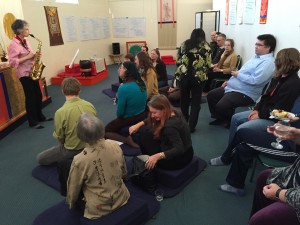



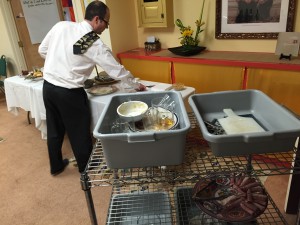







John, thank you for this comprehensive snapshot of our community meeting. It’s a big job and you did it well. Carol